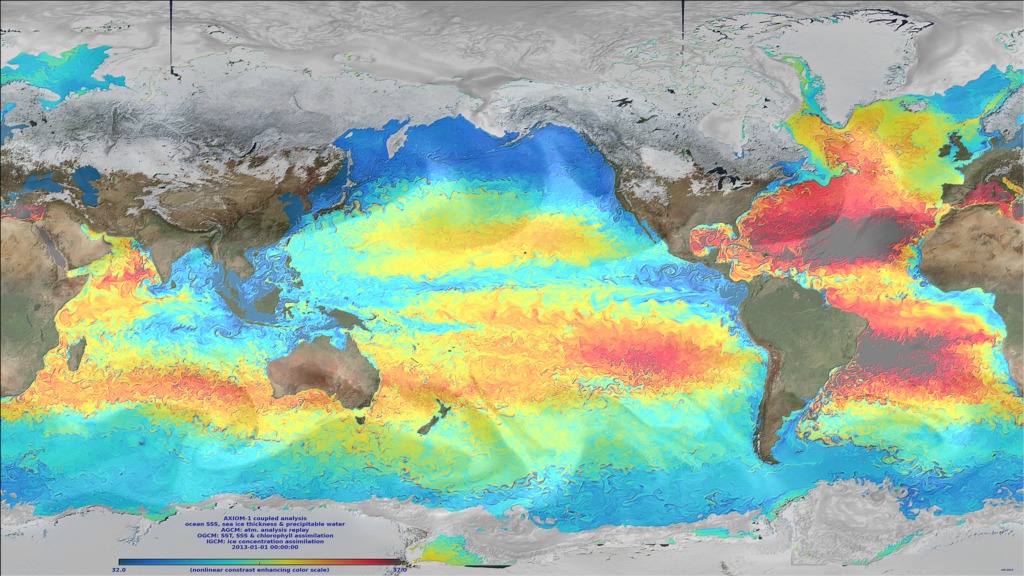AXIOM-1 Ocean chlorophyll, Sea Ice Thickness and Atmospheric Precipitable Water
This animation shows ocean surface chlorophyll concentration, sea ice thickness, and atmospheric precipitable water.
AXIOM-1 (eXperimental Analysis of sea Ice and Ocean Mesoscale version 1) is a coupled analysis of the global ocean and sea ice obtained by assimilating Aquarius sea surface salinity (SSS) and MODIS chlorophyll data together with sea surface temperature (SST) and sea ice concentrations from the OSTIA objective analysis into a global high-resolution coupled ocean/ atmosphere/sea ice model. The coupled model components are the MOM-5 ocean general circulation model, the GEOS-5 atmospheric general circulation model and the CICE sea ice model. The ocean and sea ice model horizontal resolutions vary from 11km to less than 3km in the Arctic and the atmospheric model resolution is the same as that used to produce the GMAO operational weather forecasts (25km).
As a preamble to a fully coupled integrated earth system analysis, the atmospheric model is constrained to the GMAO MERRA-2 atmospheric reanalysis (prior to June 2013) and to the GMAO operational forward processing stream (after June 2013) while the SST, SSS, ice concentration and chlorophyll data are assimilated into the coupled model using a new methodology [State Adaptive Forecast-error Estimation (SAFE): https://gmao.gsfc.nasa.gov/pubs/docs/Keppenne721.pdf] developed especially for high-resolution data assimilation.
This animation shows the ocean surface chlorophyll concentration and sea ice thickness fields (shown over grid cells where the fractional ice coverage is greater than 15%) and the vertical integral of atmospheric precipitable water (transparent overlay) sampled every 6 hours from January 1, 2013 to November 1, 2014 from a reanalysis completed with the AXIOM-1 system. The chlorophyll concentration is proportional to the ocean biomass and primary production and influences how deep solar radiation can heat the ocean sub-surface which needs to be accounted for in numerical ocean models.
- Atmosphere
- Atmospheric Water Vapor
- Chlorophyll
- Coupled Climate Models
- Cryosphere
- Earth Science
- Earth Science Reanalyses/Assimilation Models
- EARTH SCIENCE SERVICES
- HDTV
- Hyperwall
- Ice Depth/Thickness
- Models
- Ocean Chemistry
- Ocean Chlorophyll
- ocean color
- Ocean Optics
- Oceans
- Precipitable Water
- Presentation
- Sea Ice
- Sea Ice Concentration
- Sea Ice Thickness
- Water and Energy Cycle
Credits
Please give credit for this item to:
NASA
-
Animator
- Christian L. Keppenne (SSAI)
-
Project support
- Eric Sokolowsky (Global Science and Technology, Inc.)
- Steve Graham (Global Science and Technology, Inc.)
-
Scientist
- Christian L. Keppenne (SSAI)
Datasets used
-
AXIOM-1 (AXIOM-1 Coupled Reanalysis)
ID: 866
Note: While we identify the data sets used on this page, we do not store any further details, nor the data sets themselves on our site.
Release date
This page was originally published on Friday, February 13, 2015.
This page was last updated on Sunday, December 15, 2024 at 11:40 PM EST.

